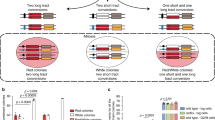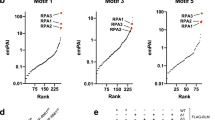Abstract
Phosphorylation of p53 on serine 15 by ATM or ATR is a frequent modification and initiates a cascade of post-translational modifications. To identify possible mechanisms that modulate p53 functions in recombination surveillance, we compared the nuclear localization of p53 phosphorylated on serine 15 (p53pSer15) and the key enzymes of homologous recombination (HR) after replication fork stalling. We demonstrate an almost mutually exclusive subcompartmentalization with Rad52, while p53pSer15 was colocalizing with 40–60% of the Rad51 and Mre11 foci. Therefore, possible sites of p53pSer15-dependent regulation seem to be sites of Rad51- rather than Rad52-dependent HR processes. Remarkably, the association of p53pSer15 with repair complexes containing Rad51 or Mre11 was transient, because less than 20% of the Rad51 and Mre11 foci overlapped with p53pSer15 after 6 h. When we examined colocalization and co-immunoprecipitation of p53pSer15 and the RecQ helicase BLM with recombination surveillance and proapoptotic functions, we observed colocalization within a fraction of approximately 70% of the BLM foci and stable physical interactions until 6 h after replication arrest. Our data suggest that p53pSer15 plays a dual role in the functional interactions with early complexes of Rad51-dependent recombination and with BLM-associated surveillance and signalling complexes within distinct nuclear subcompartments.
This is a preview of subscription content, access via your institution
Access options
Subscribe to this journal
Receive 50 print issues and online access
$259.00 per year
only $5.18 per issue
Buy this article
- Purchase on Springer Link
- Instant access to full article PDF
Prices may be subject to local taxes which are calculated during checkout





Similar content being viewed by others
References
Adams MD, McVey M and Sekelsky JJ . (2003). Science, 299, 165–267.
Akyüz N, Boehden GS, Süsse S, Rimek A, Preuss U, Scheidtmann KH and Wiesmüller L . (2002). Mol. Cell. Biol., 22, 6306–6317.
Albrechtsen N, Dornreiter I, Grosse F, Kim E, Wiesmüller L and Deppert W . (1999). Oncogene, 18, 7706–7717.
Appella E and Anderson CW . (2001). Eur. J. Biochem., 268, 2764–2772.
Benson FE, Baumann P and West SC . (1998). Nature, 391, 401–404.
Davalos AR and Campisi J . (2003). J. Cell Biol., 162, 1197–1209.
Digweed M, Rothe S, Demuth I, Scholz R, Schindler D, Stumm M, Grompe M, Jordan A and Sperling K . (2002). Carcinogenesis, 23, 1121–1126.
Dudenhöffer C, Kurth M, Janus F, Deppert W and Wiesmüller L . (1999). Oncogene, 18, 5773–5784.
Dudenhöffer C, Rohaly G, Will K, Deppert W and Wiesmüller L . (1998). Mol. Cell. Biol., 18, 5332–5342.
Foray N, Marot D, Gabriel A, Randrianarison V, Carr AM, Perricaudet M, Ashworth A and Jeggo P . (2003). EMBO J., 22, 2860–2871.
Fuchs B, O'Connor D, Fallis L, Scheidtmann KH and Lu X . (1995). Oncogene, 10, 789–793.
Gottifredi V, Shieh S, Taya Y and Prives C . (2001). Proc. Natl. Acad. Sci. USA, 98, 1036–1041.
Hopfner KP, Putnam CD and Tainer JA . (2002). Curr. Opin. Struct. Biol., 12, 115–122.
Janz C and Wiesmüller L . (2002). Oncogene, 21, 5229–5933.
Karow JK, Constantinou A, Li JL, West SC and Hickson ID . (2000). Proc. Natl. Acad. Sci. USA, 97, 6504–6508.
Krejci L, Chen L, Van Komen S, Sung P and Tomkinson A . (2003). Prog. Nucleic Acid. Res. Mol. Biol., 74, 159–201.
Levine A . (1997). Cell, 88, 323–331.
Linke SP, Sengupta S, Khabie N, Jeffries BA, Buchhop S, Miska S, Henning W, Pedeux R, Wang XW, Hofseth LJ, Yang Q, Garfield SH, Sturzbecher HW and Harris CC . (2003). Cancer Res., 63, 2596–2605.
Liu Y, Li MJ, Lee EYH and Maizels N . (1999). Curr. Biol., 9, 975–978.
Mihara M, Erster S, Zaika A, Petrenko O, Chittenden T, Pancoska P and Moll UM . (2003). Mol. Cell, 11, 577–590.
Mirzoeva OK and Petrini JH . (2001). Mol. Cell. Biol., 21, 281–288.
Miyazaki T, Bressan DA, Shinohara M, Haber JE and Shinohara A . (2004). EMBO J., 23, 939–949.
Modrich P and Lahue R . (1996). Annu. Rev. Biochem., 65, 101–133.
Moynahan ME, Chiu JW, Koller BH and Jasin M . (1999). Mol. Cell, 4, 511–518.
Offer H, Wolkowicz R, Matas D, Blumenstein S, Livneh Z and Rotter V . (1999). FEBS Lett., 450, 197–204.
Pedrazzi G, Bachrati CZ, Selak N, Studer I, Petkovic M, Hickson ID, Jiricny J and Stagljar I . (2003). Biol. Chem., 384, 1155–1164.
Petrini JHJ . (2000). Curr. Opin. Cell Biol., 12, 293–296.
Prabhu VP, Simons AM, Iwasaki H, Gai D, Simmons DT and Chen J . (2002). J. Mol. Biol., 316, 1023–1032.
Rothkamm K, Krüger I, Thompson LH and Löbrich M . (2003). Mol. Cell. Biol., 23, 5706–5715.
Saintigny Y and Lopez B . (2002). Oncogene, 21, 488–492.
Saintigny Y, Rouillard D, Chaput B, Soussi T and Lopez BS . (1999). Oncogene, 18, 3553–3565.
Sengupta S, Linke SP, Pedeux R, Yang Q, Farnsworth J, Garfield SH, Valerie K, Shay JW, Ellis NA, Wasylyk B and Harris CC . (2003). EMBO J., 22, 1210–1222.
Subramanian D and Griffith JD . (2002). Nucleic Acids Res., 30, 2427–2434.
Thompson LH and Schild D . (2001). Mutat. Res., 477, 131–153.
Wang Y, Cortez D, Yazdi P, Neff N, Elledge SJ and Qin J . (2000). Genes Dev., 14, 927–939.
West S . (2003). Nat. Rev. Mol. Cell. Biol., 4, 435–445.
Willers H, McCarthy EE, Wu B, Wunsch H, Tang W, Taghian DG, Xia F and Powell SN . (2000). Oncogene, 19, 632–639.
Yoon D, Wang Y, Stapleford K, Wiesmüller L and Chen J . (2004). J. Mol. Biol., 336, 639–654.
Zink D, Mayr C, Janz C and Wiesmüller L . (2002). Oncogene, 21, 4788–4800.
Acknowledgements
We are grateful to Dr J Heukeshoven, Heinrich-Pette-Institut, Hamburg, Germany, for Rad52 peptide synthesis. We thank Dr Fiona E Benson and Professor Dr Stephen C West, Imperial Cancer Research Fund, Hertfordshire, UK, for the generous gift of the bacterial Rad52 expression vector. This work was supported by the Deutsche Forschungsgemeinschaft, Grant Wi 1376/3-1.
Author information
Authors and Affiliations
Rights and permissions
About this article
Cite this article
Restle, A., Janz, C. & Wiesmüller, L. Differences in the association of p53 phosphorylated on serine 15 and key enzymes of homologous recombination. Oncogene 24, 4380–4387 (2005). https://doi.org/10.1038/sj.onc.1208639
Received:
Revised:
Accepted:
Published:
Issue Date:
DOI: https://doi.org/10.1038/sj.onc.1208639
Keywords
This article is cited by
-
Chromosome instability and deregulated proliferation: an unavoidable duo
Cellular and Molecular Life Sciences (2012)
-
Proenkephalin assists stress-activated apoptosis through transcriptional repression of NF-κB- and p53-regulated gene targets
Cell Death & Differentiation (2007)
-
p53 in recombination and repair
Cell Death & Differentiation (2006)
-
Defect in serine 46 phosphorylation of p53 contributes to acquisition of p53 resistance in oral squamous cell carcinoma cells
Oncogene (2006)



